The Green Issue

Hyatt Place Ottawa West opens with Five Green Key Certification



Hyatt Place Ottawa West opens with Five Green Key Certification

No cracking, no mess and no shell! Our scrambled eggs are made with 100% shell eggs, reducing your labour costs and waste.
From breakfast tacos to traditional scrambled eggs, the possibilities are endless with our carefully prepared, and ready-made scrambled egg products.
Hotels



Given that the world continues to spin out of control amidst rising geopolitical tension, disruptive technology and fear of economic recession, it’s interesting to note that travel patterns remain strong. According to Greg Klassen, senior director at New York-based Skift Advisory, who spoke at Destination Toronto’s recent Spring Briefing, this marks the first time that low consumer confidence hasn’t negatively impacted travel patterns.
Speaking on the topic Influencing Tomorrow’s Traveller , Klassen told attendees there are three phenomena at play to help us better understand travel patterns. “Travel is off-the-chart expensive, with higher rates for car rentals, restaurants, hotel rooms and flights,” adding that consumer confidence has fallen to its second-lowest recorded score in Canada but “consumers plan to spend more on travel despite those rising costs,” says Klassen. “We might not buy some things but we’re going to continue to travel.” That may be a response to COVID. “Travel is at a statistically high point. There’s an anomaly – a phenomenon, I would call it.”
Klassen referred to the second phenomena as the “tourism of Taylor Swift (and big events). We’ve never seen this happen before where there’s such mass appeal of a single individual or a single event that has created a tourism phenomenon with spending. There’s going to be benefit to the city of Toronto (and Vancouver). It’s not just Taylor Swift that can pull this,” he says, pointing to sporting events such as FIFA, adding the importance of imagining those future events and leveraging them to introduce new travellers to what our cities can offer.

Finally, the third phenomenon, says Klassen, “is the tourism of Me,” explaining that in the post-COVID world, we’ve become hyper focused on ourselves. This is fuelled, he says, by algorithms and social feeds, which know more about us than we do. “We’re all getting personalized data and information making us believe it’s all about us.”
Not surprisingly, these phenomena are fuelling a set of new trends. For example, consumers are becoming more hyper focused on their health and pampering themselves. When it comes to improved health and wellness, Klassen says it’s taken on a broader connotation, moving well beyond the spa component to incorporate sleep, performance and nutrition.
On the travel side, it means “that luxury is back with a vengeance,” says Klassen, adding that luxury is expected to grow from a $628-billion market to $1.2 trillion by 2031.
Klassen believes AI and digital innovations will continue to fuel changes to provide a more personalized view of luxury, including taking over the concierge function. He also told the audience “a loneliness epidemic is spurring growth in the solo-traveller market, with 62 per cent of consumers now travelling alone, the majority of this group being female travellers.”
Finally, he advised attendees not to forget about sustainability. “Eighty per cent of luxury travellers say they’re willing to pay more for sustainable experiences, meaning, it’s no longer a fringe idea,” says Klassen. ◆
ROSANNA CAIRA rcaira@kostuchmedia.comBY
NICK WONGROSANNA CAIRA
Editor & Publisher
AMY BOSTOCK
Managing Editor
NICOLE DI TOMASSO
Associate Editor
COURTNEY JENKINS
Art Director
JENNIFER O'NEILL
Production Manager
TYLER BECKSTEAD
Web Manager
JIM SZABO
Digital Marketing Manager
JANINE MARAL
Social Media Manager
WENDY GILCHRIST
Director of Business Development
DANNA SMITH
Account Manager
ZACK RUSSELL
Sales & Marketing Assistant
DANIELA PRICOIU
Senior Accountant
Andrew Weir, Destination Toronto; Anne Larcade, Sequel Hotels & Resorts; Bonnie Strome, Hyatt Hotels; Christiane Germain, Germain Hotels; Gopal Rao, Conestoga College; Hani Roustom, Friday Harbour Resort; Laura Baxter, Co-Star Reetu Gupta, Easton's Hotels; Ryan Killeen, The Annex Hotel Ryan Murray, The Pillar + Post Hotel; Stephen Renard, Renard International Hospitality & Search Consultants
HOTELIER is produced eight times a year by Kostuch Media Ltd., Mailing Address: 14 – 3650 Langstaff Rd. Ste. 33, Woodbridge, ON L4L 9A8, (416) 447-0888. Subscription rates: Canada: $25 per year, single issue $4, U.S.A.: $30 per year; all other countries $40 per year. Canadian Publication Mail Product Sales Agreement #40063470. Member of Canadian Circulations Audit Board and Magazines Canada. Printed in Canada on recycled stock.
All rights reserved. The use of any part of this magazine, reproduced, transmitted in any form or means, or stored in a retrieval system, without the written consent of the publisher is expressly prohibited and is an infringement of copyright law. Copyright, Hotelier 2024 ©
Return mail to: Publication Partners 1025 Rouge Valley Dr., Pickering, Ontario L1V 4N8













REACH OUT TO YOUR SALES REPRESENTATIVE TODAY TO EXPLORE EXCITING SPONSORSHIP OPPORTUNITIES.



Simon was a well-respected leader, but for me, he was an amazing mentor. I learned so much from him. While he always challenged me to be my best, his management style was demanding but always fair and respectful
- Josef Ebner, regional director, Chelsea HotelGlobal hotel industry mourns the passing of Simon Cooper
BY ROSANNA CAIRAThe hotel industry in Canada and around the globe is saddened by the passing of Simon Cooper. The renowned hotelier passed away in April after battling cancer. Cooper was born in County of Essex, Eng. The MBA graduate arrived in Canada in 1972 eager to work in hospitality. He got his start as a management trainee at the Château Champlain, where he made his entrée into Canadian hotels.
Over his renowned career, Cooper was an influential hotelier who spent many years leading brands such as Delta Hotels and Marriott Hotels of Canada, before leaving Canada in 1999 to join Ritz Hotels. In 2000, Cooper was promoted to president and COO of the Ritz Carlton brand globally.
Under his leadership, the brand realized significant growth and initiated new products such as the Ritz-Carlton Residences and the Ritz-Carlton Reserve and it also earned the highest accolades from organizations such as the Luxury Institute, and J.D. Power and Associates. The company also won the World Saver Award from Condé Nast for its Community Footprints program.
Cooper’s distinguished career as a hotelier spanned more than 50 years, three continents and five hotel brands. In addition to his time at Delta Hotels and Marriott, he also worked in Israel for Dan Hotels and at Omni Hotels. Through it all, it was his passion for people and product that moved him forward, creating a legacy of excellence and success wherever he worked. Cooper was also instrumental in the formation of the Canadian Tourism Commission, CTC, (now Destination Canada) back in 1994, as a vehicle to fuel marketing dollars to promote Canada as a destination. Two years ago, Hotelier magazine awarded Cooper with a Lifetime Achievement Award at our annual Pinnacle Awards celebration.
According to Michael Beckley, formerly with Marriott Hotels and now retired, who worked with Cooper, “Simon’s strengths as an innovative leader of people and the industry, were demonstrated with an unrivalled work ethic, and as a role model to the industry as a whole borne out by the many awards and recognitions he received over his career span. He was a consummate professional with a distinguished career earning the respect of his colleagues and peers on three continents.”
For David McMillan, former hotelier, and currently president of Axis Hospitality, Cooper was “a giant in our industry — a gentleman in so many ways. He left his huge mark in the industry through his long, successful career in our midst as a warm friend, an enthusiastic and creative leader, energetic and engaging at every level. He will be missed by all who knew him and we will reminisce.
Cooper leaves his wife, Marcelle; daughters Helen and her husband, Eric, and Susannah and her husband, Tony; son, Jason and his wife, Erin; and four grandchildren, Cole, Zachary, Benjamin, and Evan and a legion of friends and associates around the world. ◆
The 2024-2025 federal budget has dedicated $2.5 million to Indigenous tourism, thanks in part to the advocacy work of the Indigenous Tourism Association of Canada (ITAC).


“We’re pleased with the allocation of dedicated funds to ITAC in budget 2024, signaling government confidence in ITAC and backing of a national co-ordinated Indigenous tourism strategy,” says Keith Henry, president and CEO of ITAC. “This is a great first step, and we hope to see continued and long-term stability for the Indigenous tourism sector.”
ITAC will continue to advocate for more stable long-term funding that’ll help the continued growth of this sector.
Under ITAC’s 2024-2025 Action Plan, the organization has ambitious goals to make Canada the world’s leader in Indigenous tourism by 2030. Moreover, the 2024-2025 Action Plan highlights key priorities, including infrastructure and destination development, building a sustainable tourism workforce, and business development and promotion. With the appropriate funding, ITAC aims to add 800 new Indigenous tourism businesses (currently there are 1,900); add 21,000 new Indigenous tourism jobs (currently there are 39,000 employees); and contribute $6 billion to Canada’s GDP (currently $1.9 billion).
Days Inns – Canada has welcomed fifth-generation hotelier Anike Bélanger and hotel manager Audrey Hatin as new owners of the award-winning Days Inn – Berthierville, Quebec. The new owners are committed to building upon Michel Bélanger’s legacy while implementing strategic improvements to enhance guest satisfaction. Under the stewardship of Bélanger and Hatin, the hotel is ready to embark on a new chapter of hospitality excellence.

Moxy Banff, developed in partnership with Drumheller, Alta.-based company, Canalta Hotels, has officially opened.
The hotel boasts 109 guestrooms with smart layouts and retro-ski vibes, featuring toe-to-toe beds, double bunks, kitchenettes or lock-off suites that turn two rooms into one.
Guests can expect a variety of food choices including fresh-made all-day offerings from a restored 1966 VW Kombi food truck, signature Bar Moxy menu items including the Alberta Brisket Poutine, flatbreads and Reuben sandwich, a variety of food options during breakfast and après snacks.
Moxy Banff also offers several social spaces including a year-round heated courtyard with two hot tubs perfect for social events during any season and a two-in-one lobby and lounge that offers a selection of food-and-beverage options. For guests looking to hit the slopes or trails, a 24/7 ski, board and bike locker room is available for self-storage and repairs.
The Moxy team tapped Calgary artist Kirsten Bollen to design a circular mid-century mountain landscape that adorns the lobby and Edmonton artist Tanya Klimp to design large-scale abstract murals featured in both of the hotel’s grand staircases.
Coast Hotels Limited has announced a significant leadership transition aimed at propelling its expansion plans in the U.S. and driving exponential growth across North America by 2028.
As part of this strategic move, as of May 16, Jin Sasaki, current president of Coast Hotels Limited, will be re-locating to Seattle to assume the role of president & CEO of Coast Hotels USA, Inc., a newly established subsidiary of Coast Hotels Limited.
Simultaneously, Takamasa Machiura, currently holding a key leadership position within APA Hotels, will return to Vancouver to serve as president & CEO of Coast Hotels Limited.


Marriott International has appointed two new members to its Canadian senior leadership team. Susie Grynol will join as market vice-president, Eastern Canada. She most recently served as CEO at the Hotel Association of Canada (HAC). Keri Robinson will assume the position of area vice-president, U.S. Western Mountain Pacific and Western Canada, expanding her current responsibilities.


Grynol served as CEO at HAC since 2016. In her new role, Grynol will be a key member of the team supporting Managed by Marriott hotels, Select and Premium brands in Canada. She’ll ensure market-wide program implementation and drive key initiatives, working closely with area general managers and property general managers to positively impact hotel
performance in Eastern Canada. Grynol will begin her role with Marriott on June 3, 2024.
Robinson has been with Marriott International for more than 35 years. In 2020, she was promoted to area vice-president following roles as area general manager in the Seattle and San Diego markets for Marriott and Starwood Hotels & Resorts. During her time as area general manager with Starwood, Robinson had responsibility for the managed, full-service properties in Western Canada.
As part of her expanded role, Robinson will be responsible for delivering full P&L accountability and supporting efforts to drive an exceptional customer experience for Managed by Marriott hotels within the region. Robinson’s expanded role will be effective May 18, 2024.



Resorts of Ontario, in collaboration with industry leaders. The organization has committed a $3,000 bursary to bolster the Be Our Guest co-op program, emphasizing its dedication to fostering talent and addressing labour shortages within Ontario’s resort industry.
“The Be Our Guest co-op program will provide high-school students with invaluable real-world experience within the industry,” says Hani Roustom, CEO, Friday Harbour Resort. “By investing in this program, we aim to engage a demographic traditionally under-represented in the hospitality sector, while providing essential training and insights into the exciting world of resort operations, hospitality and tourism.”
The bursary will be awarded in collaboration with the school boards, to graduating high school students who intend to enroll in hospitality-and-tourism programs.
“This bursary is just one of the many initiatives we’re implementing to support the future of Ontario’s resort industry. By working together and investing in education, we can ensure that our sector remains vibrant and continues to set the standard for hospitality excellence,” said Kerri King, executive director of Resorts of Ontario.





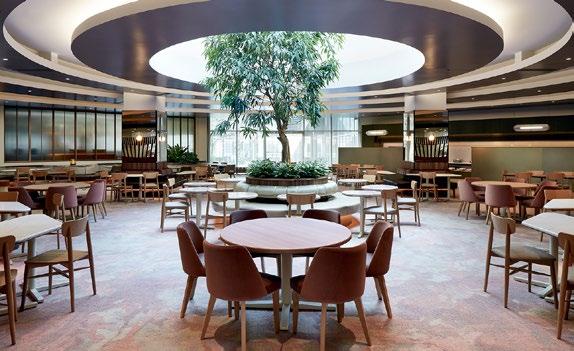
Colliers Hotels and Eastdil Secured LLC announced the sale of the DoubleTree by Hilton Montreal on behalf of Pandox AB to the Artifact Group and their partner KingSett Capital. The transaction closed on April 12.
The expansive 595-key hotel is located in the Complexe Desjardins in the heart of downtown Montreal’s Entertainment District.
The recently renovated property offers an array of amenities, including two F&B outlets, an indoor pool, a spa, a fitness centre and 46,000 sq. ft. of event space, one of the largest offerings in the market inclusive of a patio overlooking the Quartier des Spectacles.
“The DoubleTree by Hilton Montreal is a strategic acquisition for Artifact Group,” says Gaurav Gupta, president of Artifact Group. “This hotel will bring our portfolio to 1,600 rooms in the province of Quebec and will further allow us to provide the highest level of service and experience to our guests across all segments. The property is located in an area I like to call the heart of the city; a hub for activities and festivals. We’re dedicated to preserving the hotel’s sense of place while enhancing its offerings to add value to this investment.”

Our March article, “The Future of Work”, created a stir with readers as Generation Alpha hitting the workforce was mentioned. How do we manage the preferences of yet another generation, when leaders are already managing the convergence of the prior four generations? In this diverse landscape, it’s imperative we understand to effectively navigate this kaleidoscope of work means you need to engage and harness the opportunities each generation brings.
Baby Boomers were post-war babies. As such, they value equal rights and opportunity. They epitomize dedication, resilience, and a wealth of industry knowledge. They thrive on structure and hierarchy but may struggle with adapting to rapid technological advancements.
Leading Baby Boomers means honouring their experience, providing opportunities for mentorship, and bridging the generation gap by offering training in digital literacy and new technologies.
Gen X, born between 1965 and 1980, are the
first generation where their mothers worked outside of the home. They were termed “latch-key kids,” spending the after-school hours caring for themselves. Characterized by their independence, adaptability, and entrepreneurial spirit, they value work-life balance and autonomy. Seeing their parents get laid off by corporate downsizing events, they may harbour skepticism towards authority.
Leading Gen X involves fostering a culture of trust and independence, offering work-life balance, rewarding their skills over than their work ethic, and providing skill development opportunities.
Millennials, born between 1981 and 1996, came of age in a period of economic expansion. Many grew up as children of divorce.
Kept busy as kids, they were the first generation of children with schedules. They’re renowned for their tech-savviness, creativity and desire for purpose-driven work. They seek meaningful experiences, rapid career progression and a supportive work environment. Leading
millennials requires embracing their digital fluency, offering opportunities for skill development, and creating a culture of transparency and open communication. Not only do they value balance with work and life, but balance with work, life, community involvement and self-development. Flex time, job sharing and sabbaticals will be requested more by this generation.
Gen Z, born after 1996, only know a world with social networking, text messaging and smart technology, representing the first true digital natives. Characterized by their entrepreneurial mindset, digital fluency and desire for instant gratification, they value authenticity, diversity and social responsibility. Leading Gen Z entails leveraging technology in the workplace, providing real-time feedback and recognition and fostering a sense of belonging through inclusive practices and

community engagement. Enter Generation Alpha, born from 2010 onwards. Already facing huge challenges they’re shaping the future with their innate comfort with technology, environmental consciousness and global interconnectedness. While their entry into the workforce is just beginning, anticipating their needs and preferences will be essential for futureproofing our teams. Leading Gen Alpha will likely involve embracing remote work and virtual collaboration, nurturing their creativity and curiosity and satisfying their need for social responsibility. Challenges abound when leading a multi-generational workforce, from bridging communication gaps to managing differing work styles and expectations. However, by fostering a culture of respect, flexibility and continuous learning, we can transform these challenges into opportunities for growth and innovation.
Cayley Dow is the founder of Thrivity Inc. (thrivityhr.com), a human resources consulting and coaching firm that helps service-oriented businesses to thrive in the ever-evolving world of work.
One of the latest dietary trends that has emerged attempts to answer the question, “Before the agricultural revolution, what would our ancestors have eaten to keep themselves healthy through all four seasons?”
Slightly controversial because of how it repudiates veganism and the larger push for plant-based eating, ancestral eating is grounded by the anthropological evidence that humans have always been “opportunistic omnivores.” We are flexible scavengers, crafty fishers and tenacious hunters.
The tenets of ancestral dieting can be applied to any F&B outlet to differentiate the operation from competitors, offer menu items that are science-backed to support better health and appeal to the growing subculture that’s willing to pay a bit more for paleo-approved options. Here are several items to consider.

Wild berry cultivars. What’s happened over the past few centuries is that we’ve started breeding fruits for bigger yields and heightened sweetness to boost profits and palatability. The consequence is that our fruits now have an unnaturally high amount of sugar and reduced antioxidant levels; they aren’t as ‘nutrient dense’ as their wild progenitors.
Blueberries are one of the healthiest foods on the planet. Whether organic or not, most blueberries that reach the market are of the highbush cultivar, which has been engineered for its large size and high sugar content. Restaurants can wow their patrons by sourcing the antioxidant-laden lowbush varietal (often sold as frozen from Nova Scotia), which is a fraction of the size but have a deep indigo colour.


2. Sourdough bread.

With F&B outlets now having to label glutenfree items, researchers have started investigating why people in Southern Europe and the Levant can regularly indulge in grains well into their nonagenarian years without any chronic issues while North Americans feel bloated and lethargic after a couple portions of bread.
Bread that is mechanically processed over a few hours doesn’t give the microbes enough time to chew away at the gluten. This process takes days, with the yeast breaking down those gut-irritating proteins with the fermented byproduct of acid for that unmistakable sour taste. While working with sourdough requires patience and therefore is an added cost for

3. Soaked or sprouted nuts. Plants fight back through chemical warfare and coat their seeds with compounds that can be highly toxic (or indigestible) to a would-be scavenger. With this in mind, we often forget that nuts are the seeds of trees and that the outer layer is laced with antinutrients that can present problems when consumed in large quantities.
The solution that our ancestors came up with was to simply soak nuts in water for half a day or a full 24 hours so that the
Leveragingtannins and phytic acid would dissolve away from the shell. A step further was to cycle the nuts through several periods of wet and then dry conditions so that the seeds would sprout (this works for beans, too). From there, you simply dehydrate the nuts back to their dry form. Again, this is a slow and costlier process, but adjectives such as ‘soaked’ or ‘sprouted’ come with

. Goat or sheep dairy. The milk of goats and sheep is significantly healthier for us than milk from cows, with further anthropological evidence pointing to an earlier domestication point for these two species over the larger livestock.
Goat and sheep dairy products naturally contain more medium-chain triglycerides (MCTs) which are keto-friendly and help to promote metabolic flexibility for a healthier liver. Moreover, unlike cows of Northern European pedigree that contain the potentially harmful A1-casein protein, goat and sheep milk or cheese won’t have this.
5. Nose-to-tail burgers or sausages. Our ancestors ate every part of an animal, including the nose, the offal, the oxtail and every other bit of sinew was often boiled down into a collagenous stew. It follows that we should all be eating more organ meats because gram-for-gram these are technically the most nutrient-dense foods on the planet. In North America, you can’t regularly find these cuts on the menu.
Italians have trippa alla parmigiana (tripe); a common street food in Turkey is kokoretsi (spit-roasted offal); and you can easily find barbecued chicken hearts at any Thai night market. Meat producers are starting to incorporate the healthier organs into a form that’s palatable for Canadians and
Americans by grinding offal products into burgers and sausages.
6. Intermittent fasting.
We close not on a particular ingredient but on a way of eating that’s gaining popularity. On a traditional hunt, our ancestors likely went long periods without any food, with study after study showing the huge health benefits of giving your digestive tract regular breaks from meals. ◆



Adam and Larry Mogelonsky represent one of the world’s most published writing teams in hospitality, with over a decade’s worth of material online. As the partners of Hotel Mogel Consulting Ltd., a Toronto-based consulting practice, Larry focuses on asset management, sales and operations while Adam specializes in hotel technology and marketing. Their experience encompasses properties around the world, both branded and independent, ranging from luxury and boutique to select service. Their work includes seven books: “In Vino Veritas: A Guide for Hoteliers and Restaurateurs to Sell More Wine” (2022), “More Hotel Mogel” (2020), “The Hotel Mogel” (2018), “The Llama is Inn” (2017), “Hotel Llama” (2015), “Llamas Rule” (2013) and “Are You an Ostrich or a Llama?” (2012). You can reach them at adam@hotelmogel.com to discuss hotel business challenges or to book speaking engagements.
This article may not be reproduced without the expressed permission of the authors.
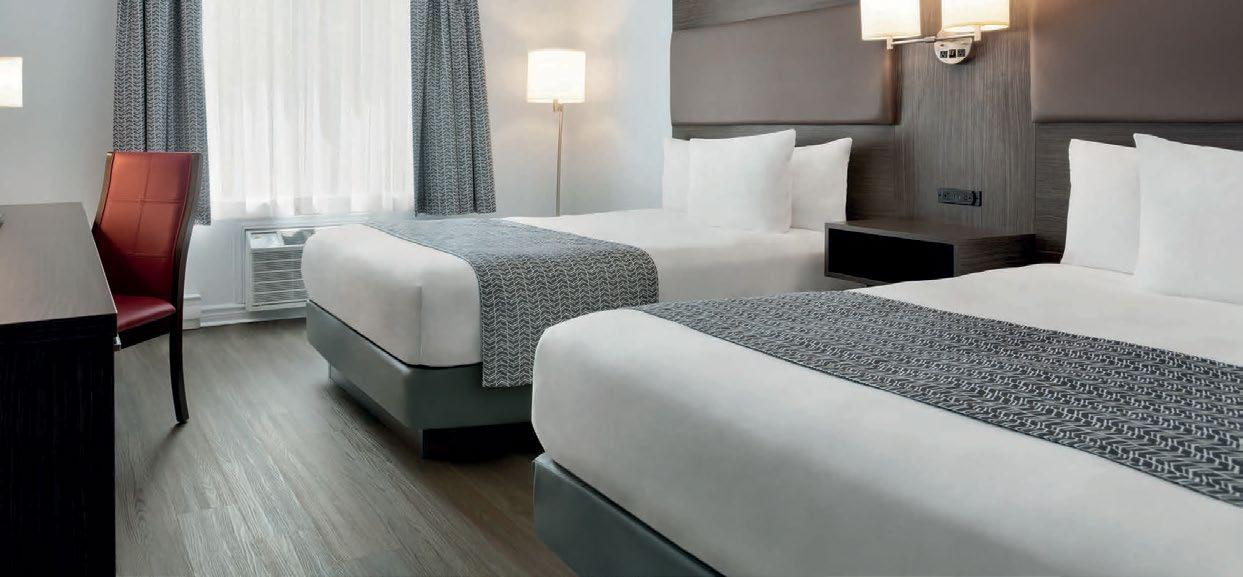


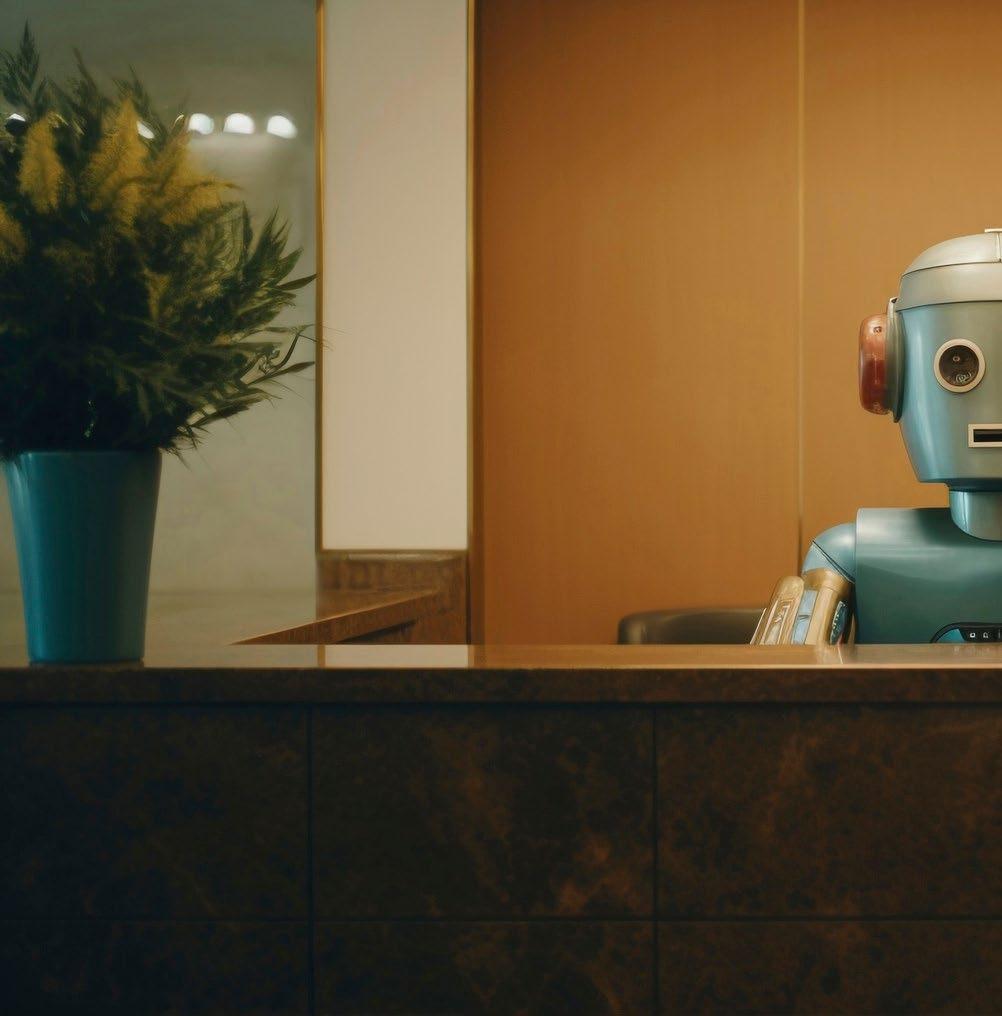

growing number of hoteliers around the world are embracing robotics and Artificial Intelligence (AI). Canada, however, is still in the early stages of adoption.
“In Canada, it’s just beginning,” says Greg Staley, general manager of Richmond Hill, Ont.-based E-Pro Bot Inc., which represents KEENON Robotics.
Founded in 2010, KEENON has
deployed unmanned delivery robots to a wide range of industries around the globe, including hotels. Its Butlerbot, for example, delivers bedding, food and amenities in a contactless and enclosed “cabin,” which ensures safety and privacy.
“There are about 50,000 [service] robots deployed in 60 countries now,” says Staley. “In China, Japan and Korea, hotel robots are everywhere. In Canada, restaurant robots are only three years old.
So, the work is just trying to educate the Canadian clientele that robots are safe, functional, return a positive ROI in most cases and create a wow factor.”
California-based Relay Robotics has integrated a dozen of its robots into ski and golf resorts in Canada, as well as in Montreal’s Hotel Monville, which has recently adopted the company’s upgraded Relay2 after having used a previous model for several years.

The fully autonomous robot delivers food, beverages, housekeeping and convenience items to guestrooms. The robot also has a “mingle” feature, which allows it to navigate lobbies and engage with guests by telling jokes and offering complimentary water.
“Robot roomservice was a unique opportunity to differentiate ourselves in a contact-free economy,” says Jean-Cedric Callies, director of Sales and Marketing,
Hotel Monville. “Safe, secure, contactfree room-service volume has doubled in one year.”
Wade Pfeiffer, CEO of Relay Robotics, says the company’s robot boosts the bottom line by “enabling guests to order directly to their room via the Relay RoomService, a custom QR code ordering system that serves as a profit centre by upselling hotel food-andbeverage items [which], in most cases,
generates enough F&B revenue to exceed the robot’s cost.”
Despite the sluggish uptake in Canada, implementation of hospitality robots globally was valued at around US$300 million in 2022, and is expected to grow to approximately US$3,100 million by 2030, mostly driven by efficiencies, cost savings and as a way to fill the persistent labour shortage, according to Zion Market Research. However, there
are still barriers to consider regarding implementation.
First, the cost of the robot itself can range widely from US$12,000 to US$30,000 depending on type and usage. Many developers offer their robots on a subscription basis. Relay, for example, charges $2,000 a month for their robots, which have an average lifespan of seven years. For KEENON’s robots, rather than providing a full figure, Staley notes a cost of $30 to $50 per day.
Additionally, integrating a robot into a hotel’s existing infrastructure and property-management system can be challenging, but Staley says KEENON is able to simplify the process.
“The science and technical aspects are already sorted out so we set up your whole facility, [including connecting] the elevator,” he says, adding KEENON trains hotel staff on the use and maintenance of the robot, including navigating safely around humans and other obstacles.
Relay also dispatches an onsite installer, who typically spends two to three days mapping the property, setting up the robot, training staff and working with elevator companies on integration. Once a robot is up and running, both companies offer 24/7 customer support.
Robots can assist with either mundane or labour-intensive tasks, freeing up staff to focus on guests.
“We don’t sell robots to take away jobs,” says Staley. “But quite often hotels don’t have a porter that they’re paying to sit there in case someone needs a toothbrush in the middle of the night, [in which case] the concierge or housekeeping might have to bring it up. [A guest] can be waiting a long time for that toothbrush. Dispatching a robot speeds that up.”
Matt Black, Marketing director at Hotel X in Toronto, says the property’s new virtual concierge Alexis, has been a hit with guests. “Some guests might not want to approach the front desk to ask for directions to the gym, for example, and would prefer to walk up to an avatar or virtual concierge like Alexis, click on a

People don ’ t necessarily notice static signs anymore, But everyone would pay attention to a robot roaming the property. It ’ s an opportunity for any business
button and have her explain information in a unique and engaging way.”
Although Alexis isn’t a robot, Black says she has reduced his workload, as well as the number of calls that come in to the switchboard.
Additionally, Black says robots are on his radar, not just for room service but also for the hotel’s gift shop.
“Traditionally, a gift shop isn’t a huge money-making endeavour,” he says. “We’ve looked at unique vending machines, [including] one that looks like a giant double glass-doored refrigerator with a bunch of cameras on it. Guests tap their credit card, open it and take what they want. Once the door is closed, the unit double-checks what they’ve taken and proceeds to charge the credit card that was pre-authorized and emails
a receipt. Guest needs can be fulfilled in a unique way but there’s doesn’t have to be a person sitting behind a desk for 12 hours a day.”
Staley points to other potential uses for robots, such as advertising services around a hotel property with a full screen. “People don’t necessarily notice static signs anymore,” he says. “But everyone would pay attention to a robot roaming the property. It’s an opportunity for any business.”
Additionally, some hotels stop roomservice at night, leaving guests to order from third-party delivery services. Once it arrives, the guest has to retrieve their food from the lobby. Staley says offering guests the option to have an onsite robot deliver the food to their room for a small fee can be a revenue generator.
“If a hotel has 100 deliveries per week at $10 each then that’s $4,000 a month just in roomservice of ordered-in meals,” says Staley. “Most hotels don’t even measure this; they have no idea how many food-delivery companies come to their hotel every day. The opportunity to do this is now.”
Staying ahead of the curve is key. “Most hotels have comfortable beds,” says Black. “We all have a lot of the same things, but what makes a [hotel] different is its people and approach to service and hospitality.” ◆

Hotels are placing concerted focus on pursuing ESG targetsBY DANIELLE SCHALK

The evenTs of recent years have broadened the public understanding and expectations around environmental sustainability, social issues and corporate governance. As Hilton’s report, The 2022 Traveler: Emerging Trends and the Redefined Traveler highlights, “A new sense of caring has emerged and is expected to strengthen… travellers are expected to care more about sustainability and community efforts, and they’re looking to remain loyal to brands, companies and organizations that align with their values.”
“More and more, our customers are expecting that we toe the line, if you will, and continue to champion sustainability and appropriate practices,” says Edwin Frizzell, regional vice-president, Central Canada and general manager of the Fairmont Royal York in Toronto.
“Canada has a great reputation internationally, as a country and as a destination, that really does put sustainability at the forefront, which I think gives us an advantage,” he adds, noting he has seen the important role sustainability plays in the broader industry’s success through his role as a board member of Greater
Toronto Hotel Association and Destination Toronto.
Placing concerted focus on pursuing Environmental, Social and Governance (ESG) targets, “is something most of our guests are looking for and very appreciative of,” shares Sabrina Offers, director of Private Residences and Owner Relations at Four Seasons Resort and Residences Whistler, as well as the leader of the property’s Green Team. “Sometimes [these initiatives] come with a little bit of challenge, like when you change certain things that people have been used to over the years,” she notes. But, the effort is ultimately worthwhile.
And, while environmental sustainability initiatives have often been the most visible aspects of the industry’s ESG efforts, approaches have continued to diversify and evolve with the culture and consumer expectations.

“[The industry has] evolved in regard to including some newer resources and strategies that don’t only look at the environmental concerns, [but focus more on] social equity and economic viability,” Offers explains. This, she notes, reflects “a broader understanding of sustainability, which includes responsible sourcing and energy efficiency, but also community engagement.”
Striking a balance between multiple facets requires a more holistic view of decision making and sustainability. It also often includes initiatives that reach beyond the bounds of the hotel and its operations. For example, Four Seasons Whistler takes part in a local biodiversity support program designed to protect toads during the Western-toad migration that takes place around nearby Lost Lake.
Offers also points to programs such as donating used linens, furniture and equipment that’s in good condition to benefit the needy; supporting local artists and artisans by featuring them throughout the property; and building relationships with local resources such as the Squamish Lil’wat Cultural Centre, which helps guests connect to the local community and Indigenous culture.
For those seeking to balance out ESG focuses to better address all aspects of responsible and sustainable operations, Marie Pier Germain, vice-president, Sales and Marketing for Quebec-based Germain Hotels, notes, “There’s a lot of things you can do in terms of social improvements — for diversity, equity and inclusion — [such as] donations and sponsorship programs. When you start looking at different opportunities, there’s a lot that can be done.”
But, Germain also notes that part of the reason
environmental commitments tend to be front and centre in the industry is due to tourism being such a resource-heavy sector. “Tourism is an industry that consumes a lot, and that has a larger impact on the environment,” she explains.
Because of this, Germain Hotels’ approach has been increasingly shaped to ease the process of making more sustainable travel decisions for its guests. As Germain explains, the team’s approach is: “Let’s try to make the right decisions for our guests so that they don’t have to carry the weight to make the decision.”
The growing push toward net-zero operations is also creating continued emphasis on environmental responsibility, with many nations and companies working toward net zero carbon emissions by 2050, in line with the Paris Agreement.
But, in order for this to be effective, there needs to be clear communication of the efforts being taken, including measurement and reporting of progress toward goals.
As CBRE’s Pacific head of ESG, Su-Fern Tan, explained in a recent report titled Technology’s Role in Achieving ESG Targets: “Energy efficiency is essentially the old sustainability game that’s becoming more mature. We’re now starting to talk about water efficiency, waste, embodied carbon and nature repair. It’s all interconnected, interdependent and getting pretty complicated, and underneath all of this lies the data.”
In line with Accor’s commitments on this front, the Fairmont Royal York has undertaken a number of initiatives in recent years, including the elimination of guest-facing singleuse plastics. As part of a transformation unveiled in November 2023, the historic hotel also underwent the largest heritagehotel retrofit in North America in order to become certified as a Zero-Carbon Building – Performance Standard by the Canada Green Building Council (CGBC).
The Fairmont team is continuing to tackle ambitious targets. “For 2024, at the Royal York particularly, we’re undertaking a pretty significant focus on food-waste reduction,” shares Frizzell. “We have a 25-per-cent food-waste-reduction ambition for this year, which is the largest goal in the company.”
In its pursuit of this goal, the team at the Royal York is leveraging AI technology to help focus its efforts and better understand the food-waste it produces. Using the Orbisk food-waste monitoring system, food waste can be scanned, identified and measured at 12 locations throughout the property. The system also weighs waste and generates reports and recommendations for the team automatically. And this,
Frizzell notes, is proving very valuable.
“It really is quite incredible technology and the amount of data and analytics that we’re able to pull from that, [as well as] the recommendations that the system itself makes for us, makes our ambitious 25-per-cent reduction goal seem much more within reach,” he shares.
Frizzell is quick to stress the significant amount of dedication and resources required to properly execute projects of this magnitude, requiring substantial investment and buy-in at all levels within the hotel.
“When we want to implement something we need to have the buy in of the people [involved],” agrees Germain. “So training is really important, making sure staff understand why we do certain things.”
When developing this training, Germain also notes that Germain Hotels paid particular attention to the vocabulary used to communicate. “It has an impact on how people understand what you’re talking about,” she shares, pointing out that this kind of clarity also helps combat greenwashing. “I’m excited about what lies ahead for us and where we can have a positive impact.
As ESG practices within the industry continue to grow and evolve, tools, targets and understandings around these topics will continue to shift too.
To illustrate, Frizzell points to increasingly sustainable F&B offerings that eliminate some of the more resource-intensive products as an area to observe and consider.

“I can envision a restaurant menu here at the Royal York that would be 100-per-cent plant based in the not-too-distant future, which would give our guests a great culinary experience that also contributes to our overall sustainability goals,” he notes.
“There’s a lot of evolution happening in a number of different spaces in our sector,” Frizzell adds. “And I think we’re are just starting to scratch the surface.”

he Hyatt Place Ottawa West, owned by Ottawa-based hotelownership group Stolat, was built from the ground up with sustainability in mind. The local ownership of the new hotel, which opened in June of 2021, conceived, planned and built the hotel to minimize its impact upon the environment and then made the decision to operate the hotel with a true spirit of corporate social responsibility.
For Stolat, the decision to build a sustainable hotel from the ground up was a no-brainer.
“There were two pillars to the decision. The first was it’s just the right thing to do, isn’t it?” says Cal Kirkpatrick, partner & VP of Stolat Hotels. Kirkpatrick and his team are no strangers to green initiatives, with two outposts of its retail store, Terra 20, which specialize in environmental and environmentally sustainable products, currently open in Ottawa.
The second pillar, he says, is that financial modeling proved building the hotel was a good business decision. “With new construction, there’s an empirical argument to be made that

it makes good business sense in terms of the initial capital investment and your ability to recover those costs over time.”
The 140-room Hyatt Place Ottawa West, the winner of Hotelier’s 2024 Green Leadership Award, is one of the few hotels in the world to open up with a Five Green Key Certification, thanks to its many sustainable features. The building has 225 solar panels on the roof and the carbon capture is equivalent to planting 38,225 trees annually or slightly less than an entire tree for every guestroom, every day. It also uses earth-friendly, geo-thermal heating and cooling, which required the drilling of multiple, extremely deep boreholes under the future parking lot to utilize the constant temperature available deep underground.
Extensive piping is used to transfer this earthbased energy to the hotel, thus reducing or eliminating the need for energy-intensive heating and cooling. All public spaces are equipped with motion sensor lighting controls to reduce energy consumption. Multiple EV charging stations


are available for guests. Meeting space window blinds are kept closed when possible, during the summer to lower air conditioning usage. Construction of the hotel was done using tilt-up construction which can significantly reduce CO2 emissions during construction and over the life of the building.
And the results speak for themselves as the initial investment in solar panels and geo-thermal heating and cooling has significantly reduced the operating costs of the building. According to Hyatt Hotels, the hotel is currently saving approximately $25,000 to $35,000 annually on energy costs compared to a similar hotel without the same level of sustainability.
“The combination of earth energy and our solar panels allows us to have a renewable energy source that means writing a smaller check to hydro every month,” says Kirkpatrick. “Our analysis said we would get a seven-year payback on our initial capital investment. It’s probably going to be more like nine, but in the lifecycle of a hotel, which is 40 to 50 years, a nine-year payback period made a lot of sense to us.”
He says he’s had the debate with appraisers and consultants over the years, even before opening the Hyatt Place Ottawa West, around whether sustainability drives revenue, increases occupancy or grows ADR. "The answer is difficult to directly trace, but by reducing utility costs, it certainly improved the bottom line," he says, adding it does drive brand loyalty from some corporate accounts whose sustainability practices align with those of the hotel.
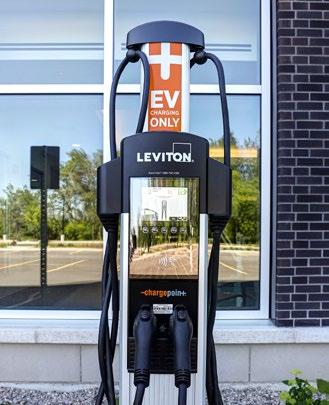
The team at Hyatt Place Ottawa West, comprised of 62 employees from 20 countries, is led by general manager Alison Hunter, who met the challenges of opening a new hotel in the middle of a pandemic head-on, including supplychain challenges, labour shortages and a lack of awareness in Canada of the Hyatt Place brand. But as she looked to take the next step in her career, that of general manager, she was drawn to the project.
“When I met this ownership group, I saw that my morals and values aligned with theirs so tremendously,” she says. “And what they were doing on the sustainability front was honestly the deal sealer for me.”
Hunter says the importance of sustainable choices shouldn’t be limited to hotels; it should be in every business and in every home. And while the task can seem daunting, she says every small change makes a difference.
“I think sometimes people look at [sustainable practices] and think ‘we can’t do it, we can’t put geothermal in our six-year-old hotel.’ No, but if you make one small change in one small area, and one small change next month, there are so many small things that if, as an industry, we all change, we can help literally change the world. I know that sounds a little corny. I’m kind of a corny person. But it really comes down to having the confidence to know that making small bite-sized changes isn’t only a good thing for the planet, but in the end, it’ll make operational sense. It’ll make economic sense.”
I think sometimes look at [sustainable practices] and think ‘we can’t do it, we put geothermal in six-year-old hotel.’ but if you make one change in one small and one small change next month, there many small things if, as an industry, we all change, we can literally change the
- Alison Hunter

The industry is sitting up and taking notice of what Hunter and her team are accomplishing. The Hyatt Place Ottawa West stands as a shining example to business people and hotel owners that it makes economic sense to build and operate in an environmentally friendly manner. Its commitment to environmental sustainability, including the installation and operation of a beehive on the roof, makes the property immensely more attractive to a client base of corporate clients as they seek to reduce the environmental impact of their travel programs. Within the past few years, major corporate accounts and meeting planners are insisting that hotels answer questions regarding their environmental programs prior to acceptance into travel programs. In addition to Hotelier’s Green
people
[sustainable think can’t our hotel.’ No, one small small area, change are so things that we help the world

Leadership Award, the property has received accolades as Hyatt Best New Property Award 2021, Best Performance in Sustainability by Best Ottawa Business Awards 2022, Hotel Association of Canada Green Key Environmental Award 2022, Ottawa Tourism Awards of Excellence Finalist in Sustainability Category 2023 and Canadian Museum Of Nature 10th-Annual Nature Inspiration Awards Finalist 2023.
While Stolat was behind the hotel’s development, Kirkpatrick was quick to credit Hunter and her whole team with the property’s success. “This was an ownership-led initiative before we had a hotel-management team in place. But it would be fair to say that they’ve completely embraced the idea − Alison in particular,” he says. “It’s one thing for us to have a certain philosophy and a policy, but somebody else has to execute on it and they do that every day. So, kudos to them.” ◆

Germain Hotels refines its sustainability initiatives with new five-year strategic plan
BY NICOLE DI TOMASSO


ell before sustainability became a widespread concern, Germain Hotels had already started implementing green practices, such as local sourcing (1988), geo-thermal energy and low-flow showerheads and toilets (2007). Over the last two years, the Quebec-based company behind Le Germain, Alt and Escad Hotels embarked on a thorough examination of its stance on sustainabledevelopment issues, encompassing all its business units, including construction, administration, operations and catering. To facilitate this process, Germain Hotels enlisted the expertise of Coesio, a Canadian consulting firm specializing in sustainable development.
In 2022, the company conducted a comprehensive survey of more than 300 stakeholders, including investors, guests, suppliers and employees, to gain insight into their priority areas.
“You can’t talk about the impact you have unless you have measurements,” says Marie Pier Germain, VP, Sales and Marketing, Germain Hotels. “I’m glad we took the time to measure and assign ourselves concrete objectives.”
Drawing from these insights, Germain Hotels — this year’s recipient of KML’s Green Leadership Award for Environmental Stewardship — formulated a five-year strategic plan as well as an action plan for 2023-2024. At the start of 2023, the Board of Directors and the Executive Committee signed a Sustainable Development Commitment Charter, confirming the company’s intention to do more to reduce its impact on the environment and increase its impact on the community. In May 2023, Justine Nadeau was appointed the company's first Sustainable Development project manager to oversee the action plan.
The action plan focuses on three key areas, including local sourcing, sustainable projects and community spirit.
In this area, 2023 highlights include updating its procurement policy to add eco-responsible criteria; gaining recognition from the Aliments du Québec au menu program for all its restaurants in Quebec (menus composed of at least 60 per cent Quebec-sourced products year round); collecting abundant harvests with more than 30 varieties of fruits and vegetables from its gardens at Alt Hotel St. John’s and Le Germain Charlevoix Hotel & Spa; and partnering with Too Good To Go to combat food waste at Le Germain Hotel Ottawa. The pilot project involves creating “surprise bags”
containing unsold produce, which local residents can purchase at a reduced price. This year, the company aims to extend this practice to other restaurants and produce more than 1,000 bags of compost, saving more than 800 kg of food waste from incineration or landfill.
Additionally, Le Germain Hotels adopted a new housekeeping uniform designed by Montreal-based Tristan. Old uniforms are recycled or donated to charities. Germain Hotels also partnered with Kotmo, a Canadian B Corp certified company for its sustainable and re-usable promotional items, which includes a water bottle, manufactured in Quebec. This year, the company aims to train 100 per cent of its general managers on responsible-sourcing issues.
Last year, Germain Hotels opened Alt Hotel Calgary University District, bringing its portfolio of hotels to 19. The property was constructed with energy-efficient design features, including a green roof, reflective membrane, enhanced insulation (dual-layered envelop), glass materials, watermanagement systems and responsible sorting of construction waste. Its LEED Certification is currently in progress.
More broadly, the company has carried out an initial measurement of residual materials (RM) management at all its properties and a characterization of two of its sites. This performance analysis by property enabled the company to prioritize its actions for the coming years. The company recorded 443.6 tonnes of RM generated annually and aims to bring this total amount down 15 per cent in 2024-2025, with an overall diversion rate of 26 per cent, by implementing projects in each property.
Furthermore, Germain says it aims to reduce the use of single-use plastic water bottles by 70 per cent, eliminating more than 250,000 during the year. To meet this goal, the company has added several water stations throughout its hotels (lobbies, gyms, et cetera); installed Naturizzata water-filtration systems in restaurants and meeting rooms; and added a jug in hotel rooms and an OVO carbon-filtered water station in Le Germain hotels. One type

of bottled water, a re-usable bottle made partly from locally recycled aluminum, will continue to be sold in minibars and at Altcetera counters.
Lastly, the company has introduced washable and re-usable slippers at all Germain properties across Canada, in collaboration with Kotmo, to replace over-packaged, single-use slippers, with the goal of eliminating 25,000 disposable slippers annually.
“One of the challenges is making sure that the decisions we make as a company also have a positive impact on the guest experience,” says Germain.
Most of Germain Hotels’ seniormanagement team is involved with several organizations. The value of donations in 2023 reached more than $300,000 in support of 600 local causes. For example, at the opening celebration of Alt Hotel Calgary University District, rather than offering guests a welcome gift, the company donated 25 overnight stays on their behalf to the Alberta Children’s Hospital to welcome families in need. This year, the company aims to add volunteer involvement to the philanthropic efforts in its hotels.
For the well-being of its teams, Germain Hotels obtained the Concilivi Seal and created a Family-Work Balance committee to draft a guide. It’s also raising awareness among employees and managers of DE&I concepts and unconscious biases through 100 hours of training in different formats. Additionally, the company created two new positions dedicated to training, IT trainer and training advisor. In a similar vein, Germain has welcomed 54 interns from 22 different schools this year, a third of whom have been hired full-time.

Additionally, Germain says the company runs “quarterly sustainability challenges in its hotels to help equip teams with the right knowledge and make actions easy and enjoyable. The challenges run on a three-month basis then we compare and name the winners. It’s a way to get everyone involved.”
Currently, Germain Hotels has a number of new projects under development, including offering a new menstrual product by Iris + Arlo for employees and guests; collaborating with university scholars who are studying various sustainability issues and suggesting solutions; introducing toothbrushes made from re-claimed Canadian maple wood and toothpaste in tablet form; and exploring potential partnerships with start-ups.
Next year, Germain says the company will narrow in on reducing greenhousegas emissions.
“Sustainable development at German Hotels isn’t the responsibility of a single individual; it’s a shared responsibility embraced by all,” says Germain. ◆

Rosanna Caira: What inspired you to work in the hotel industry and what has your trajectory looked like?
Andy Loges: I was a bellman in a hotel while going to college for criminology, with the aim to be a police officer. Since I was a kid, I wanted to be a police officer. And I just loved [working in the hotel]; I loved the people, I loved what I did, I had fun. The pivot point from law enforcement to hospitality was when I met the GM, and decided that’s the job I want one day, that’s what I want to be and I never looked back.
I’ve been very fortunate to work with amazing people. Obviously, like many of us, my start was grassroots — I started as a bellman, I was a doorman and also a night auditor for a couple years before moving to the rooms side and then food and beverage.
I’ve been a director of Catering and a director of Food and Beverage. My first GM role was in Richmond, B.C., at the Richmond Inn & Conference Centre for about four years and from there I moved to the Toronto Marriott Bloor Yorkville and the last 14 years I’ve been with Hilton.
RC: What have the past two years looked like for you personally and professionally since the pandemic ended?
AL: Horrible. Put it this way, I had hair before the pandemic. The uncertainty was the most challenging part — you’re open, you’re not open — [it] made it difficult to deal with your team, from the few that you had, running a skeleton crew with five per cent occupancy, to the ones that you had to let go. And then the staff that were in the wings waiting to come back but you didn’t have answers. My most difficult conversations were with team members who would reach out every couple months and say, ‘well, what am I coming back?’ and you didn’t have the answer.
On a personal level, it was extremely stressful being honest with them. People appreciate honesty, even if it’s not what they want to hear. They want to know that you’ll tell them what you know, even if you can’t promise them anything. You have to do the best you can, because you have to live with yourself, and that’s how I got through it.
RC: What are your expectations for the next year vis a vis travel forecasts and business expectations?
AL: We came out of it extremely strong. We were locked down Q1 of 2022 but by Q4 of 2022, we were doing amazing business. And not just the rooms, but the catering business, the restaurants — everybody was starting to come back. Then 2023 was a good year, although a bit more challenging for Hilton Toronto as we were going through a massive renovation at the time, but it was still a very good year. Future wise, we’re focused on what we’re always focused on and that’s the business, leisure and group business. We have huge expectations for this year and feel very positive about it.
RC: You recently completed a major renovation of the

People appreciate honesty, even if it’s not what they want to hear
hotel. Tell us about the project and how it’s transformed your hotel?
AL: In 2022 we started renovating 374 of our 600 guestrooms. We finished that project in May of 2023. So now all 600 guestrooms have been renovated. That was the last piece of it. The big projects this past year were our newly opened Frenchy Bar et Brasserie and a full lobby renovation.
RC: F&B is always a challenging area and your new restaurant promises to help solve some of those challenges. Tell us about Frenchy and what made you change your focus from Tundra,
a Canadian restaurant to now a French brasserie.
AL: We started working towards a new restaurant concept in 2019, but had to shelve that during COVID. In August of 2022, ownership decided to re-look at it so we tweaked the design a little bit. We did partner with some people to produce this. Tundra was created in 2000, so it’s 24 years old. It was given a facelift in 2012, but now it was time for a change. We investigated what’s around the hotel before we landed on this concept for Frenchy. There was a collaboration of a lot of individuals and people to do this. It’s not a stuffy French restaurant; this is sophisticated, open, fun and a little
edgy — a ‘don’t-take-yourselftoo-seriously’ kind of French restaurant — just great food and a welcoming place to meet. It’s open for breakfast, lunch and dinner and we’ll be doing a Sunday brunch. We offer Happy Hour, DJs two days a week and a band a couple days a week. We engage the full lobby experience, so when you walk into our lobby, you want to go to that bar.
RC: Who did you work with on this project and how has feedback been so far. Do you have an outside company running the F&B?
AL: DesignAgency helped us create the whole project. We used Scale Hospitality, which are amazing partners, to design the restaurant portion of it and work with our teams and help us with the branding. I’m very proud of the collaboration of the three, and with the hotel team. Our consultants are still active, but this is run by the hotel and the talented F&B team at the hotel. We’ve kept Scale on to help us continue that legacy.
RC: As part of your major renovation, how have your hotel rooms changed. How are today’s design trends fuelling changes in the guestrooms?



AL: They’ve become airier, the furniture pieces are not as large and the rooms overall are sophisticated and beautiful. Your desk chair is comfortable and the desk is not large. It’s kind of like a home-awayfrom-home. People do a lot of work in their guestrooms so the lighting is super important. The technology is important that you put in the guestrooms today — it’s all those details.
RC: What do you think today’s guests are looking for in their hotel experience. Has the post-pandemic guest changed at all?
AL: I think they still want the same things. After the
pandemic, we thought the world was going to change. We weren’t going to clean rooms; we were going to do things differently; we weren’t going to serve guests in restaurants; we’re going to do takeout with plastic forks and knives. But that’s not what people want. If anything, the pandemic has taught us we’re resilient and that the need to meet, to travel, to visit, to have experiences is stronger than ever. We went through SARS; we went through 911; we’ve gone through all these and there was so much uncertainty. But as soon as we got out of it, we’re stronger because we realized that there’s such a demand and a desire to travel. For today’s traveller, expectations have increased because the prices
have increased so there’s an expectation that you’re getting a better experience.
RC: During the last few years, we’ve all had to re-assess our priorities of what’s truly important. Do you think the pandemic has given hoteliers a new appreciation of employee welfare, benefits, equality, health, work/life balance, sustainability?
AL: We’re in the people business, so hopefully we’ve always had that at the forefront and had those discussions. But has the pandemic made us change the way we think about these issues? Absolutely. We’re looking more at flexible hours, [and] the blurred line between your professional life and your home life. As an industry, we have to be a lot more flexible. Pre-pandemic, we probably looked at people that work from home and asking “are you really working today?” I don’t think we have that bias anymore.
We need to have different policies and procedures in place, but it’s also not as simple as that, to make rules for a hotel that operates 24/7. What works for some departments and individuals, might not work for ones that have to be boots on the ground. It has to be on a case-by-case basis.
RC: How would you rate your hotels efforts on diversity, equity and inclusion?
AL: It’s at the heart of everything we do. When it comes to recruiting initiatives, we partner with local groups that are outside of our traditional hospitality pool

of talent, such as Covenant House, or Tent Partnership for Refugees or WoodGreen. We have a very diverse group of just over 300 employees at the hotel and we encourage team members to include everybody in their culture and share their culture. For example, we have an engineer that’s been with us for 25 years celebrating Eid with team members. He comes and celebrates and breaks bread, and has a lunch for all team members in the hotel. And it is just an amazing thing to see and share cultures. It’s just so heartwarming when you do something like that.
RC: What role does sustainability play in your hotel operation and what special initiatives do you promote in this area?
AL: As a brand, we’re trying to reduce our carbon footprint by 50 per cent by 2030 and reduce water use by 50 per cent by 2030 — this is on a more global side. At the property level, we have a system called LightStay that tracks our progress. We create goals for saving energy and water. This is also something we can use to speak
to our customers. For example, we can actually track and plug into the system and tell you that your conference has this carbon footprint but this is what we can do to change the carbon footprint that your event is going to have. So, it’s more than just lip service and is going to continually evolve and become a focus going forward.
RC: Do you believe the industry can come out of the crisis and chaos of the past four years to create a better and healthier industry?
AL: I think we came out of this stronger than ever and we seem to do that every time something massive happens. We now have to re-examine our operations in areas such as work-life balance and people’s expectations of what a job is. Those are pretty important issues we’re going to have to navigate through and decide how to manage going forward because I doubt that’s going to go away with our younger generation entering the workforce. So, we have some work to do. But I think we’re in a good position.
RC: What is the greatest change you anticipate for your business moving forward?
AL: I’d like to say we were open minded; we need to be more open minded and maybe look at options when it comes to strategies around people, putting them in positions that maybe they’ve never been in. Also, we’re having more dialogue about issues we would never have had before and I think that’s an amazing thing because that also generates passion from those individuals that might want to move around in their roles. We put people in silos before and I feel like we’ve like knocked the silos down now. ◆

Breakfast programs can be a profit centre for hotels
BY NICOLE DI TOMASSOAhotel’s breakfast program, once considered a mere convenience, is now recognized as strategic profit centre that significantly influences guest experience, revenue generation and brand differentiation.
“Many hotel brands in the midscale and economy segments offer complimentary breakfast as part of their amenities to attract guests,” says Steven Gilbert, director of Procurement, Choice Hotels Canada. “However, upscale and luxury hotels generally charge a premium for breakfast, especially if they offer extensive buffet options or a higher-end experience.”
The Mizzen Restaurant at The Westin Harbour Castle, Toronto runs a breakfast buffet and à-la-carte menu in tandem seven days a week.
“The breakfast buffet is accompanied by a live-action chef making omelettes,” says Daniel Craig, executive chef, The Westin Harbour Castle, Toronto. “I’d say it’s probably a 75-per-cent split, with the majority of guests opting for the buffet.”
Grab-and-go items, including breakfast sandwiches, hummus and crackers and cold-pressed juices, are available at Harbour Coffee Bar and Marketplace, located in the hotel’s lobby.
“Breakfast has always been and continues to be our biggest capture,” says Craig. “Given the type of property and its location, it’s easy to grab breakfast and kick start your day. A lot of guests will go to the island or explore the downtown core and that’s where they’ll have lunch or dinner. We see most of our guests pop in for breakfast to get their day setup.”
“At Choice Hotels Canada, we provide a complimentary hot buffet breakfast for guests staying at the majority of

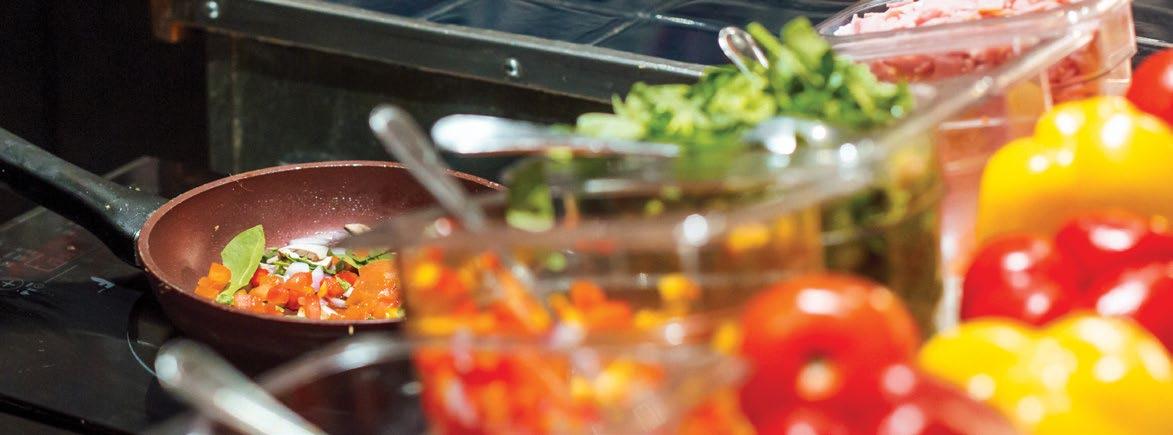
our mid-scale brands,” says Gilbert. “Buffet offerings provide a wider variety of choices and allow guests to customize their meals according to their preferences of hot items, such as pancakes, waffles, eggs and sausage, or cold items, such as cereal, yogurt and fruit. Buffets offer a more convenient experience, which is often preferred by families, individual travellers and groups, such as sports teams.”
However, Gilbert says some hotels do offer à-la-carte menus.
In 2020, Jacky Bruchez, national F&B director, Germain Hotels, says the company decided to remove the cost of breakfast included in its room rates due to a drop in attendance. Today, Germain properties offer both à la carte and buffet options as an additional amenity.
Le Germain Hotel & Spa Charlevoix, Le Germain Hotel Ottawa and Le Germain Hotel Quebec, for example, offer breakfast buffets mainly because of guest volumes, says Bruchez.
“Previously, 55 to 70 per cent of guests [had breakfast in the hotel],” says Bruchez. “Once we removed the price in 2020, attendance dropped to around 40 per cent. Today, we see attendance in some provinces drop between 20 and 25 per cent for weekdays.”
Breakfast programs serve as platforms for culinary innovation and local partnerships. By showcasing regional specialities and collaborating with local producers and vendors, hotels can create unique breakfast experiences that reflect the destination’s culture and gastronomic heritage. This not only
adds a distinctive flavour to the guest experience but also strengthens the hotel’s ties to the community.
“Germain Hotels works with bakeries and other businesses to showcase local product as much as possible,” says Bruchez. “Working with local suppliers has always been a part of our core identity.”
Several Germain hotel properties have also partnered with cafés to provide easy grab-and-go options for guests. Last year, Germain Hotels re-opened Jackson Café, located within the Ottawa Art Gallery (directly accessible from Le Germain Hotel Ottawa).
Additionally, hotels must adapt their offerings to align with evolving consumer preferences and dietary restrictions. With an increasing emphasis on health and wellness, guests are seeking nutritious and wholesome breakfast options that go beyond traditional fare. Hotels can capitalize on this trend by incorporating superfoods, organic ingredients and plant-based alternatives into their breakfast menus to cater to healthconscious travellers and differentiate themselves from competitors.
At The Westin Harbour Castle, Toronto, Craig says avocado toast, classic breakfast (eggs, choice of protein, potatoes) and eggs benedict are the top à-la-carte sellers. The buffet, on the other hand, has a gamut of options. “Guests are choosing to eat healthy, so many of them are choosing eggs, fresh fruit, cold-pressed juices, smoked salmon, et cetera,” says Craig. “The egg station sees the most action. Guests can order any style they’d like — over easy, scrambled or just egg whites.”
Craig continues, “We also run a
feature of the day that’s quite popular, which can be anything from samosas to croque monsieur to French toast,” adding that the buffet also offers a range of gluten-free options.
Technological innovation can enhance the efficiency and personalization of breakfast programs. From mobile ordering apps to in-room dining tablets, hotels can leverage digital platforms to streamline the breakfast experience, facilitate customization and gather guest feedback in real time. As a result, hotels can gain insights into guest preferences and behaviours, allowing them to tailor their offerings and marketing strategies accordingly.
“We’ve recently added induction chafer dishes to our breakfast equipment package,” says Gilbert. “They offer several advantages over traditional chafing dishes for buffets. Not only are they more appealing, but they also provide precise temperature control, ensuring food stays at optimal serving temperatures. Induction technology is also more energy-efficient and safer.”
At The Westin Harbour Castle, Toronto, Craig says a “coffee and espresso machine is currently the only self-service unit in use.” However, the hotel is undergoing extensive renovations which are expected to be completed by 2025. At that time, Craig says the Mizzen Restaurant will debut a new design, interactive stations and new equipment.
One key consideration is cost management as breakfast programs entail









expenses related to food procurement, preparation, staffing and overhead. To optimize profitability, hotels must strike a balance between offering a compelling breakfast experience and controlling operational costs through efficient procurement, portion control and wastereduction measures.
Craig says that while supply hasn’t been an issue, the hotel is feeling the effects of rising food costs, adding that the cost increase of eggs and butter in particular “pop off the page.” As a result, the hotel has increased pricing.
With regard to labour, Craig says “it’s generally been the same staff pre-pandemic versus now. We’ve always had an omelette chef and we also have a buffet runner who peels and cuts fruit, builds the charcuterie and stocks the buffet. Wages have gone up, but there hasn’t been a big impact in terms of labour.”
However, Craig says the hotel’s labour model changed slightly. “Generally speaking, we’ve seen a lot more single diners at the hotel who are choosing to sit at the bar instead of sitting at a table.
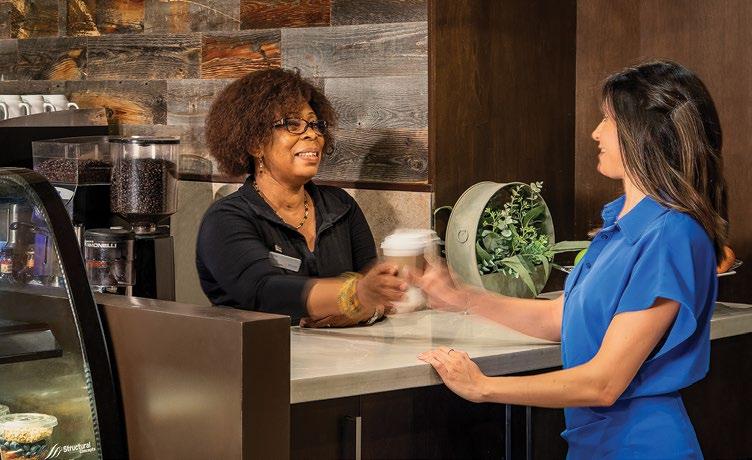
This changed our model a bit since one bartender can take care of four or five guests at a time. There’s less impact on the floor and less space taken in the restaurant.”
Craig continues, “We’ve also seen an increase in business travellers and room-service revenue. Some single diners prefer to have breakfast in their room to eat and work at the same time as opposed to coming down to the restaurant.”
Depending on the area and volume
for each Germain-owned hotel, Bruchez says food costs went from approximately 30 to 37 per cent, and labour costs went up nearly 10 per cent.
Overall, hotel breakfast programs offer a myriad of profitable benefits, ranging from guest satisfaction and loyalty to increased revenue and operational efficiency. By prioritizing the quality and convenience of offerings, hotels can stand out in a competitive market.

Kiosk platforms delivering benefits for properties of all shapes and sizes
BY DENISE DEVEAU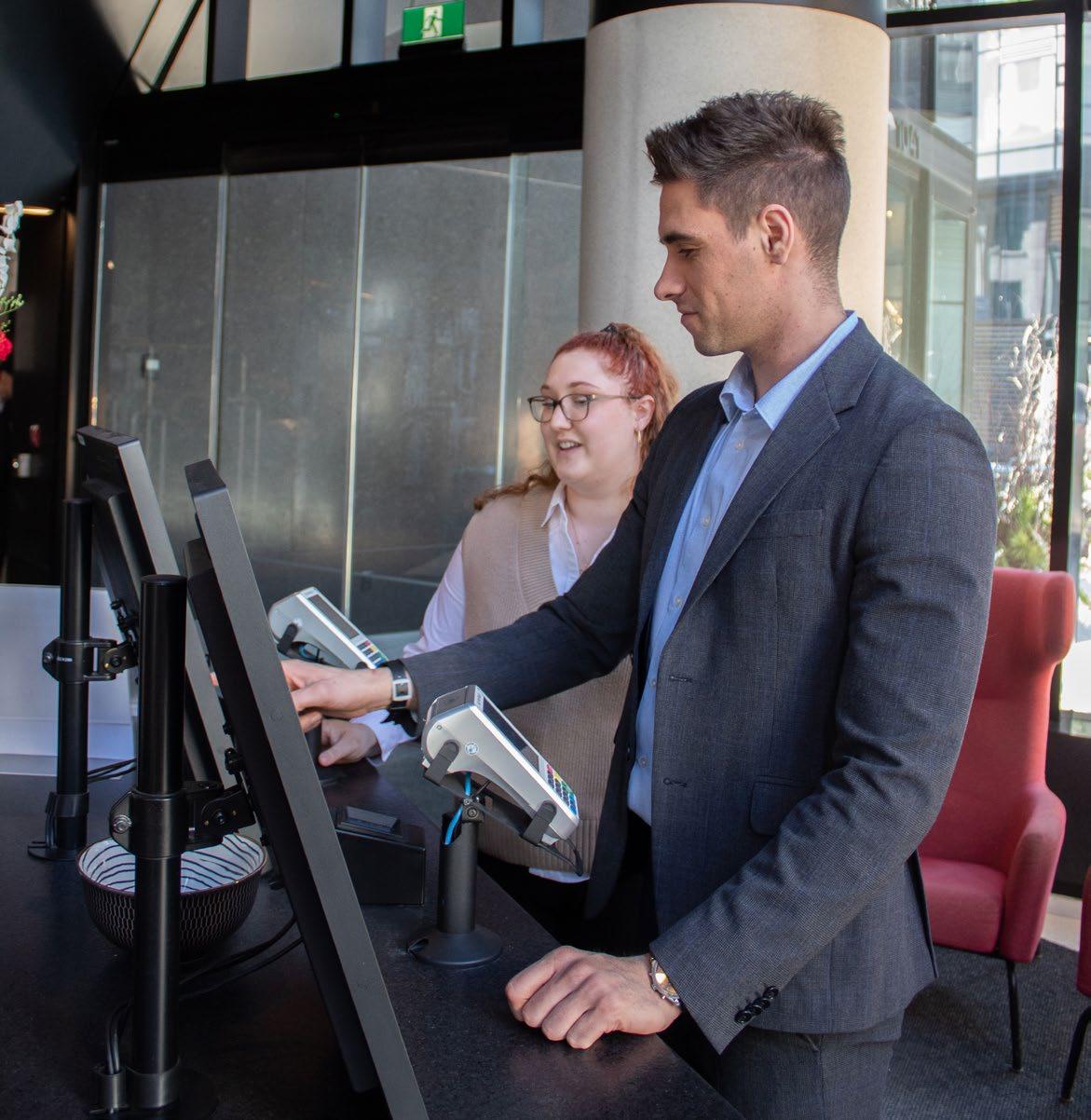
When check-in kiosks were first introduced in the early 2000s, uptake in the hotel sector was underwhelming.
With the advancements of technology, time, and a more receptive demographic, the platform has moved well beyond a novelty experiment, to a mainstream must-have for many hotel operators.
Whether the motivation is staff shortages, customer demand, or simply cost and labour savings, hotels in all sectors are finding plenty of reasons to offer self-check-in capabilities.
“The technology for the sector was not quite right at first and the market was not ready,” says Fabricio Titiro, director of Product
 Hotel Monville
Hotel Monville
Management – Partnership, Oracle Hospitality. “Kiosks were clunky and too big. Cost and implementation were also troubling.” Early sweet spots tended to be high-traffic venues, such as theme parks and casinos, as well as budget properties looking to reduce labour costs.
Today, kiosks are much more streamlined and can support multi-function integration, including mobility and web-based services. “Most properties are looking to offer omni-channel as well as speed and convenience to the people that want it,” says Titiro. “People on both sides are also far more comfortable using the technology.”
Hôtel Monville began planning self-check-in services two years prior to its official opening in March 2018. The initial idea, says Jean-Cédric Callies, director of Operations, was to capitalize on the location in downtown Montreal and its proximity to the convention centre. “Because the average length of stay is very short — two nights on average — we wanted to make sure we offered an efficient experience for guests.”
Their calculations showed that a regular check-in typically took two to five minutes, while the kiosk was one minute. “The technology allowed us to gain time for the front-desk agents to take care of guests with other queries. It wasn’t about removing people to save costs, but rather to enhance the guest experience.”

There were lessons learned along the way, he admits. “At first people thought the kiosks were a business centre rather than a check-in area, so we switched the displays from horizontal to vertical to make them more visible. We also had to train visitors and staff, which took about six months.”
The most important lesson learned is that every technology innovation being brought to the table is that it’s a step-by-step process, says Callies. “You don’t do everything at the same time. There are so many different layers on the learning curve. You have to build it one brick at a time to do it right.”
For example, eight months after opening, they implemented web check-in 48 hours prior to the guest’s visit, reducing the time spent on the kiosks to pick up their room keys to a mere 30 seconds. Eighteen months later, they added upselling capabilities during the check-in process, such as breakfast options, parking, and loyalty membership enrolment, among others.
Basecamp Resorts introduced self check-in with its first property in Canmore in 2017. “As our model was based on the Airbnb concept where check-in is common, freedom for the guests was a top priority,” says Danielle Spooner, vice-president of Operations, Basecamp Resorts. “We were just doing it on a larger scale.” The company has since expanded self check-in to 13 properties and counting.
Not only has self check-in made it easier for arriving guests and front-desk personnel, but it has always helped drive operational efficiencies.
Advanced web check-in functionality is one example. Guests making reservations online are asked to complete the contactless check-in process five days prior to arrival. “If we discover any fraud or an invalid card, we’re able to notify the guest or cancel the reservation ahead of time,” explains Spooner. “We have zero no-shows, which means we’re bringing in revenues with every reservation.” On arrival, guests are given an entry code key they can use to go directly to their room if they choose.
The system is fully integrated with the PMS software, allowing the operator to offer upgrades or discounted rates, or present special food-and-beverage offers. “Everything is so seamless, we never need to have physical kiosks on site,” says Spooner.
Callies says that self check-in has evolved into a new luxury perk for many. “Being able to go to their room and their meetings without lineups all add to the luxury experience for corporate travellers. Sometimes the best technology is the one you don’t see.”
Human interaction is still integral to the process, he adds. “We still have the front desk, and we still have people helping guests at the kiosk. We believe in using technology as a tool, not as a replacement.”
An unanticipated plus is that self check-in services are proving extremely helpful in a time of drastic labour shortages, says Callies. “It enables us to have better elasticity in terms of variation of occupancy. If it drops a lot, kiosks can help to keep you afloat. This is where it has become a game changer.” ◆

In hotel kitchens, as in foodservice outlets of all kinds, the landscape has changed. The challenges that were in play 10 or 15 years ago, such as staffing shortages and high ingredient costs, have only intensified. Sustainability has become a priority rather than a frill.
Dining habits have changed, expanding demand for prepared meals and takeout.
The good news is that technologies that were in their infancy in 2020 are beginning to generate novel solutions to longstanding challenges. New kitchen equipment and new uses for traditional appliances have
been enabled by robotics and AI, which have become practical tools that are transforming kitchens and solving problems.
An analysis of this year’s hospitality trends by the commerce platform Lightspeed predicts that “we’re likely to see AI topping the list of hospitality trends
for the foreseeable future.”
Among the areas where AI can be helpful are inventory, where digital apps can track and predict demand and reduce waste, and ordering, where digital menus can upsell based on previous customer choices.
At the 2023 Hospitality Show in the U.S., KEENON
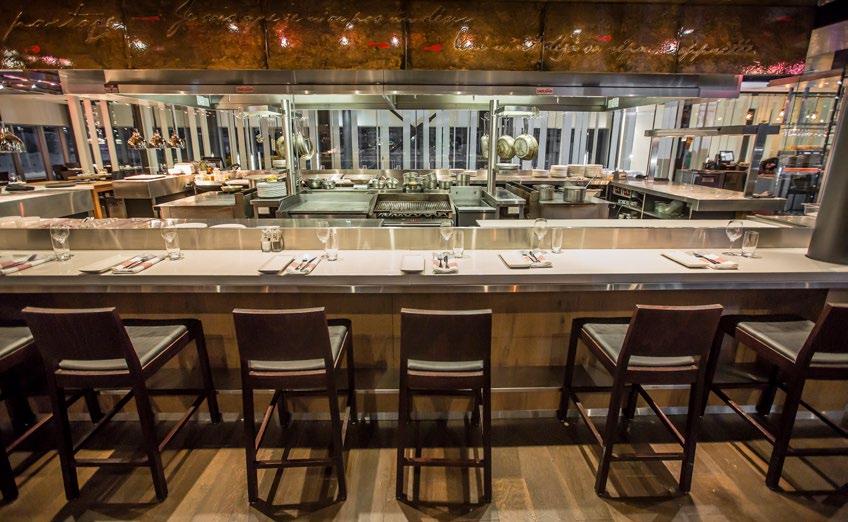
Robotics showcased seven hotel and restaurant robots that could greet guests and hand out information flyers. Their KEENON BUTLERBOT W3 is programmed for room delivery and can even use an elevator. KEENON also visited the RC Show in Toronto in April to show off their new multi-functional delivery robot, the Dinerbot T10.
Based in Oakville, Ont., Gastronomous is developing a
network of interconnected smart appliances, such as robot arms designed to save labour, standardize results and reduce costs. They even have a hamburger robot.
You may feel dismayed to imagine line cooks with rivets and bolts where their aprons should be, but where these technologies are truly making themselves felt is in small, clever tweaks to existing equipment, such as the familiar combi oven.

Like many hospitality businesses, Germain Hotels has felt the scarcity of skilled labour, especially at properties in more remote locations, such as Charlevoix, Que. Some staff may be new to kitchen work, with modest knife skills and much to learn. One way to maintain a high kitchen standard while training new staff is to take advantage of all the functions of programmable equipment.
“We’re using them even more for what they’re capable of doing, such as being able to start the cooking three or four hours later,” says Jacky Bruchez, Germain Hotels’ national director of F&B. Food can be set up to cook at a designated time, or kept at point on a steaming mode, he says, enabling even beginner staff to turn out high-quality fare by following a few simple steps.
Of course, digital programming is
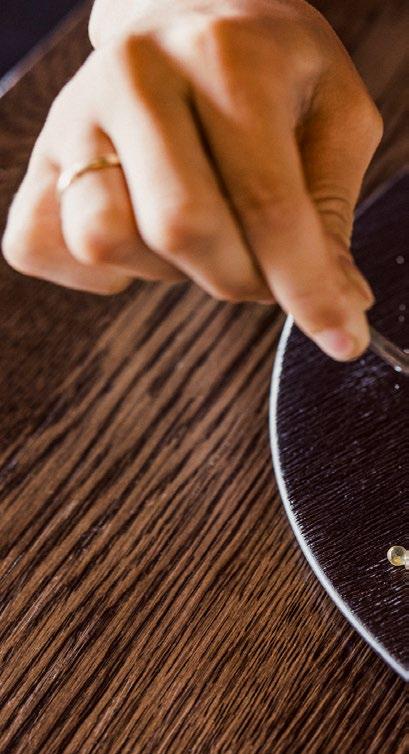
Dessert

nothing new for the hospitality industry, but it has gradually been gaining traction, says Bruchez, “through airlines, then cruises, then hotels.”
While Bruchez says RATIONAL “is one of the leaders in Canada,” he has also been impressed by Unox equipment, in particular, its SPEED-X, an innovative self-washing combi speed oven. Using microwave technology and controlled humidity, it offers extremely fast cooking times. “Something that would take six hours in a combi is going to take an hour and a half in this equipment,” he says.
Another area that’s not necessarily
Sosta! Pizzeria Alt Hotel Toronto Airport pizza oven Les Labours Restaurant Le Germain (left); Les Labours RestaurantLe Germain Charlevoix Hotel & Spa
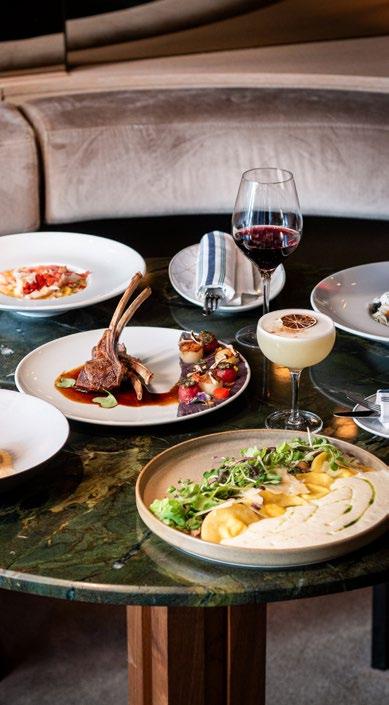
With a dependable high-volume coffee machine, staff costs drop and ROI comes more quickly.
To combat the high price of ingredients, Bruchez stretches every dollar by finding creative uses for vegetable trimmings and other kitchen byproducts using a dehydrator. “It could be carrot peels just to bring some extra texture. When we’re doing a bisque, we’ll take all the lobster shells and use them first to do the reduction. After, instead of throwing away the shells, we dehydrate them and do a little crumble to add on top, maybe mixing it up with a bit of bread. It would bring this crispy texture.

new, but where there has been interesting progress over the past few years, is coffee service. A good barista is a rare commodity, and an excellent coffee takes time to make.
“What we’re looking at more and more is new equipment where it’s automatized. There aren’t a lot of them that are able to match a barista, but there’s one company that stands out: Eversys,” says Bruchez. “They’re a Swiss company, and they’ve been there for quite a while.” The Eversys line commands a high price point but is durable and “keeps a constant high-quality coffee standard.”
Bruchez points out there’s a wide choice of coffee machines on the market, but “as soon as you have a high volume, it’s hard to keep consistent quality.”
Instead of using 70 per cent of the lobster, we’re using approximately 95 per cent.”
Omcan is a brand he’s using lately but he says there are many options, and the machine doesn’t have to be very large to be useful. For example, small quantities of fruit left over from assembling a buffet can be dried for use as cocktail garnishes. Like the programmable ovens, these can be set up to work overnight to save space during busy daytime hours.
Space is at a premium. During COVID, when dining rooms were shuttered, food prep could move into empty dining rooms, and take-out or delivery meals could be packaged in a luxuriously roomy environment. But now, every extra chair in the dining room once again represents potential revenue, and kitchens have to shrink to make room. Multi-function machines and programmability are helping to solve the space crunch.
Apart from the cost of investing in new equipment, the only barrier is acceptance. “When you say a machine is going to do exactly the same thing as you’ve been doing, and maybe even better, it goes against the ego, but you have to understand we don’t necessarily need to stand there and stir it all the time,” Bruchez says. “If you’re looking to be more efficient, there are good tools out there to be more efficient.” ◆
Bar Le Germain

These four women have left their mark on the hotel-design sceneBY AMY BOSTOCK
Principal & Global Design Lead, CHIL Interior Design/managing principal, B+H Architects Vancouver Studio
Q
What is it about your approach to hotel design that makes you stand out?
I’ve always felt that if you aren’t thinking about the guest and their experience first and foremost, then the design will be without purpose. Putting their experience at the forefront will guide meaningful design solutions.
Q
How does innovation drive your design choices?
I strive to create something new with each opportunity — big or small. That means thinking of everything with a little less restraint and sometimes actively pushing yourself to view the design from a whole different perspective. Innovation can be found in everything — from conceptualizing the space to using new materials, but it’s really important to not recycle ideas.
Q What are some of the top challenges you face during the design process?
Challenges range with each project as some can be about those hidden costs that arise in a renovation, for instance, that can erode the interior-design budget over time, or ensuring all the voices in the project from the owner to the brand to the operator are aligned. Others are about rising costs in materials or trades as well as ensuring momentum on a long project is maintained.
Q
How important is it to have sustainability at the forefront of hotel design?
I’m excited when developers start a project with that at the forefront, especially in new builds. Having the


hotel brands and operators also push sustainability within the operations of the hotel is so important and needs to be matched in all aspects.
Q What part of the hotel do owners spend the most time and money on??
Over the last number of years, F&B and lobbies have been getting much more attention and budget invested in order to attract visitors beyond the hotel guests and to position the hotel as a neighbourhood amenity overall. In some markets, we’ve seen a more paredback approach to the hotel guestroom in favour of elevating the public areas, which has made sense to many guests who look for a well-rounded and inspiring experience and often don’t use the five-piece bathroom, for instance,
during their one to two-night stay.
Q What is your favourite hotel project you have worked on and why?
I loved The Dorian, an Autograph Collection (Calgary) where we were able to see our original concept and vision become a reality. This was a new-build hotel and spanned about six years for us with a client who was a great collaborator and inspiration in her own right. We still have to pinch ourselves that the client, brand and team trusted us to deliver such a truly unique and exciting project. They also really supported the design and created a completely holistic experience from tip to tail with their branding, F&B operations and general love of the property that makes us so proud to have been a part of.
QWhat is it about your approach to hotel design that makes you stand out?
I believe in timeless design, so we don’t follow what’s trending in the market. Instead, we follow what that particular location and brand requires, based on the culture we’re looking at. So even though our firm is Canadian, we work everywhere in the world. We want to make sure that wherever we design, it’s elegant and timeless. That’s a key because nobody wants to spend a lot of money to design something that you have to re-design in five years or so. Ownership appreciates when the designers can design not only a beautiful product, but something timeless that can last for more than 10 years.
QHow important is it to have sustainability at the forefront of hotel design?
My family is very cautious about what we use and how we’re using and I implement the same rules from my family to my company. About 80 per cent of the materials we use [in hotels design] are recycled. For example, we found carpeting made from wool and recycled plastic from a factory in London that’s collecting recyclable plastic from the ocean and using it as thread, which we can use in the carpets. It’s also durable, which is important in hotels. We’ve also used recycled brick from the construction to design accent walls — we always try to be creative. We also try to help the community where we build, such as using local suppliers and giving back in a charitable way.
QWhat are some of the top challenges you face during the design process?
My passion is resorts, but working in Costa Rica, Dominican Republic or Mexico comes with some unique challenges. For example, when I was working on a property in Mexico City, one of the unique challenges was that Mexico City has a lot


of earthquakes and to make sure that that structure was very stable, there were big columns throughout the space. We approached it as a part of the uniqueness of this particular space and we treated it as artwork by painting them unique colours.
At the St. Regis Resort Kanai, challenges came from the fact the property was located on mangrove swamps, which was protected by UNESCO. You can just chop through it, you have to gently remove it, place it somewhere else. That’s why it took eight years. The architecture was a circle, which was quite unique, so each of rooms was like a pizza slice and that was a challenge to design. At the end of the day, it’s up to me to make it work. It’s my job is to make the problem disappear and to make the [design] process as easy as possible.
Q Do you have a signature design element?
No and I’m actually very proud of that. Every single hotel is very unique, and [the design] is based on the requirements for ownership is based on requirements from the brand. I want every hotel I design to offer a different experience, different unique details. My goal for the company is to create quality, not quantity.
Q What is your favourite hotel project you’ve worked on and why?
Every project is my favourite project. I love being involved in the process and seeing the reaction of the people on their faces when they see [the finished product]. And I love to come back to a property after it’s opened to see it and reading the reviews from guests. At the end of the day, that’s what’s important.
Q
What is it about your approach to hotel design that makes you stand out?
Understanding that hotel guests are away from their home for either leisure or business, LUX Design’s primary focus at the initiation of the interior-design process is to ask ourselves, ‘How can we create a welcoming and immersive experience for the guests?’ Through strategic design, our goal is to create an environment that fully engages a guest’s senses and emotions that reflect the hotel’s theme, brand and narrative.
Q
Do you have a signature design element?
I believe that a great design doesn’t need to be overdone to be luxurious, so I create spaces with understated elements that give a feeling of ease, calm and longevity.
Q
What are the top two trends in hotel interior design for 2024/2025?
Biophilic design is the top trend for hotel interior design this year. It involves incorporating natural elements into the hotel’s environment to connect humans with nature. This includes integration not only of vegetation but also natural light, raw materials and organic shapes. This leads to our selection of the second trend, which is organic shapes seen in materials, furniture and design elements that ultimately promote a sense of well-being and calm.
Q What are some of the challenges you face during the design process?
Most of the challenges revolve around balancing interior design ambitions with budget constraints. While supply-chain issues were more prevalent in previous years, that has improved in 2024.
Q
What part of the hotel do owners spend the most time and money on?
Owners typically allocate a large portion of their budget to the lobby as it’s the first impression for guests and often serves as a meeting spot for guests, meetings or places to rest.
Q
What is your favourite hotel project you have worked on and why?
At LUX Design, every project takes our team and clients on a creative journey, rendering it difficult to single out just one. However, a recent noteworthy project is The Tapestry Hotel by Hilton located in Niagara Falls, Ont. With the spectacle of the falls and the lively city surrounding it, our client sought a sanctuary for their guests that would provide a serene juxtaposition. Our design strategy to achieve this was to integrate tranquility through the use of natural elements, including wood panelling and features, as well as subdued hues, offering a space for relaxation from the bustling Niagara surroundings. The vibrant pops of colour in the restaurant give a sense of play, while the guestrooms have a darker ambiance to give guests a sense of pure relaxation and rejuvenation.




QWhat are the top two trends in hotel interior design for 2024/2025?
The top trends I’m seeing for 2024/2025 are sustainable design and natural materials. Beautiful natural-wood finishes in flooring, cabinets and decor, and woven textures in fabrics and stone. A lot of brand design shows this and I feel they’re on point, considering the need for sustainable design and the move to be more of an informed consumer and steward of the planet.
Q
What are some of the top challenges you face during the design process?
Timing and realistic expectations. Timing has become a challenge in that there are many hotels with PIP’s that need to be done yesterday. Logistics and budget don’t always coincide with the timing of a project and that can put stress on the design. Realistic expectations are a common thread
throughout the process. From engaging your designer to completion, to knowing there are many moving parts to design, we try to manage the project expectations by continuous communication. Keeping everyone in the loop truly helps.
Q
Do you have a signature design element?
I like to add a hint of black to a design in a subtle way. I feel this offers a place for the eye to focus as you take in a space for the first time. It doesn’t have to be much, maybe a simple light fixture finish or hardware on a piece of furniture. To me, this gives a sense of calm, as some spaces can be overwhelming.
Q
What is it about your approach to hotel design that makes you stand out?
We use a “guest-first” viewpoint for our approach to each design. When I first see a property that’s scheduled for renovation,
I love to walk in and take in the whole interior — good or bad. Then, seeing the potential and knowing the design direction, my creativity goes to work. But always keeping in mind the guest experience — how will they feel? Is the lobby easy to navigate? These questions and others like them keep us focused on the guest’s interaction with the space.
Q How important is it to have sustainability at the forefront of hotel design?
We have grown, in part, to be a “throwaway society,” but we’re seeing the folly in that philosophy. Simple changes can be made that we’ve been seeing in hotel design, such as the complimentary amenities no longer being a one-time use item. The consideration, too, of the lifecycle of FF&E is on my mind. Using more quality made pieces that will last a full life cycle is not only good for the environment, but also good for the bottom line.
Q What part of the hotel should owners spend the most time and money on?
Depending on the size and layout, lobbies should be invested in. First impressions are everything and you only get one chance to make a good first impression. It doesn’t have to break the bank either but [having] some thought, again, to the guest experience, can really drive the design. Close behind in importance are the guestrooms. It would be a lost opportunity to forget the space your guest is sleeping in. Comfort should be a priority in the design.
Q What is your favourite hotel project you have worked on and why?
One of my favourite projects has likely been one of my most challenging projects – the renovation of a hotel in northern Ontario. The building was old, not maintained and big changes needed to be made. Architecturally, there were some hurdles, so that kept impacting the design. But in the end, it was a success. The hotel now gets great reviews and is often booked up in advance. My favourite piece in the whole design though, is the mural in the lobby. We had it commissioned by a young artist who really wowed us. ◆
Ria Letcher has spent decades working to make her dream a realityBY ROSANNA CAIRA
Ria Letcher literally grew up in the hotel business. As a seven-year old child in Hay River, NWT, she helped fold towels and sheets, vacuum and shovel the parking lot of her mom’s Caribou Motor Inn. “There wasn’t much I enjoyed about it aside from the adventures of being a child in a huge space and shoveling snow. I was a child of the outdoors and that’s where I found my happiness.”
Years later, the native of Fort Simson, NWT, who was raised further north in a First Nations’ community, known as Wrigley, NWT, left home to attend a residential school where she completed her education before attending Aurora College for management studies. “It provided me with all the tools I needed to achieve what we’ve achieved.”
Today, the mother of four operates the North Nahanni Naturalist Lodge, an Indigenous-owned and operated eco-lodge and wilderness resort situated on Cli Lake, named after her husband Loyal’s, great-great grandfather Chief Joseph Cli, and whose uncle Stanley, had always dreamt of owning a lodge there.

When his uncle passed away, Loyal carried on his dream and in 1998, the husband-and-wife team opened the six-room lodge that also includes three cabins. The lodge has become an important cornerstone of the community, incorporating and promoting Indigenous culture, while offering hiking trails, plant and medicinal walks, and ― since the pandemic ― even healing camps.
Fittingly, the lodge’s philosophy is “Experience a Dream,” and the team works hard to make the dream a reality by creating an oasis where guests can enjoy water sports, connect to nature and also educate themselves on Indigenous culture. “Our style is welcoming, warm, comfortable and experienced,” boasts Letcher, adding “we have a beauty-and-the-beast philosophy — be our guest and put our service to the test. We aim to provide the best service possible in the middle of the wilderness.”
Despite the challenges of the past four years, Letcher continues to promote the area as a travel destination. She’s hoping to “increase the number of rooms and additional facilities to support the increased capacity and desire for private meeting space.”
She believes location sets her lodge apart from others. “We have the only full-service hotel located on Cli Lake in the Nahanni Mountains near the Nahanni National Park, a UNESCO World-Heritage Site.”
When asked what makes the lodge successful, she states, “We struggle every day to make this possible and operational for our family and community. We’ve raised our children in this lifestyle; they’re grown now and appreciate what we’ve done. They’re present with us and continue to work to see the dream realized now for their children. This to me is success.”
Biggest lesson learned through the pandemic: No one is immune. We have this notion that we’re so isolated here in the north but COVID debunked that myth as it reached all corners of the world.
Stress busters: I handle stress a lot differently than I did in my twenties. I now have incredible resolve, problem solving and foresight to avoid stressful situations.
Biggest mistake and what was learned from it: I learned to persevere, move on and not dwell and beat ourselves up. Nobody else is doing what we’re doing and there’s no set way of doing this.